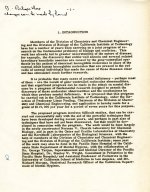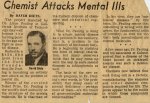| Molecular Disease and Mental Disorders |
|
In 1953 a significant change occurred in Pauling's scientific life, he developed an
interest in mental disorders and began applying his concept of molecular disease to
mental deficiencies and mental illnesses. Pauling usually demonstrated the link by
discussing sickle cell anemia and phenylketonuria (also know as PKU and phenylpyruvic
oligophrenia). Phenylketonuria is a hereditary disease in which babies develop physical
and mental disabilities after birth because their bodies can not break down phenylpyruvic
acid. Articles about the treatment of phenylketonuria started appearing in the early
1950s, and by 1961 many realized the link between diet and disposition of those suffering
from phenylketonuria. When Pauling gained an interest in phenylketonuria in the mid-1950s
it was known that phenylketonuria manifests itself in persons who are homozygous recessive
for this genetic abnormality. Likewise, sickle cell anemia affects those who are homozygous
recessive for sickle cell hemoglobin.
Starting in the fall of 1955, Pauling began discussing phenylketonuria in his speeches
about molecular disease and drew parallels between phenylketonuria and sickle cell
anemia. For example, Pauling mentioned that phenylketonuria is caused by an inborn
error resulting in the sufferer's inability to manufacture the enzyme that converts
phenylalanine to tyrosine. Ultimately, Pauling foresaw a day when artificial enzymes
would be used to treat these types of diseases. In addition, Pauling stated that most
mental disorders were molecular diseases that resulted from abnormal concentrations
of molecules within the body and he thought that sickle cell anemia could be used
as a template for understanding mental ailments. "The discovery of the abnormal hemoglobins
has provided us with a far deeper understanding of the hereditary hemolytic anemias
than existed before. In the same way, much may be done in increasing our understanding
of phenylpyruvic oligophrenia [PKU]."
By the mid-1950s, Pauling had associated himself with mental ailments and had unequivocally
connected mental disorders to his concept of molecular disease.
|
|
Click images to enlarge

"A Proposal to the Ford Foundation on Biochemical and Structural Chemical Factors
in Relation to Mental Disease, Especially Mental Deficiency." August 1, 1955.

"Chemist Attacks Mental Ills" 1956.
"Dr. Pauling explained the reasons behind his developing interest in the field of
mental deficiency. His research in hematology has now developed this area to the point
where other researchers have taken over and will carry on."
|

